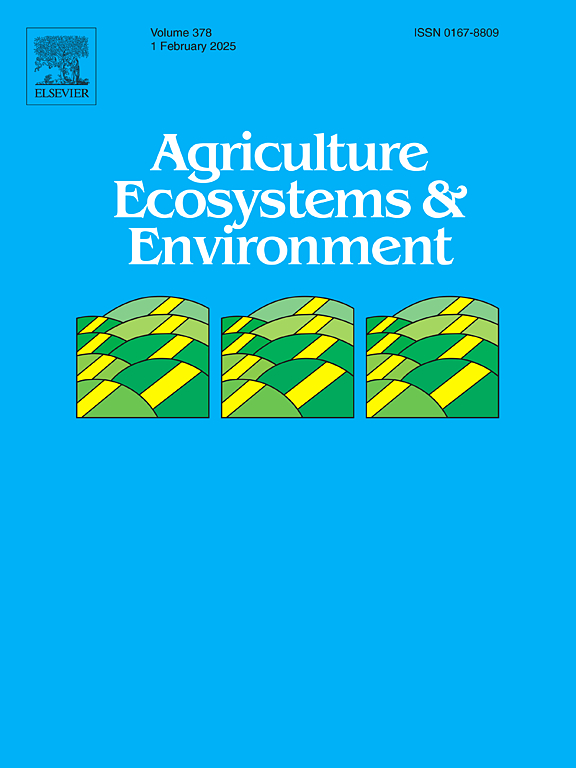Cascading effects of landscape, mediated by mesoclimate, on carabid communities and weed seed predation in winter cereals
IF 6.4
1区 农林科学
Q1 AGRICULTURE, MULTIDISCIPLINARY
引用次数: 0
Abstract
Agricultural intensification, landscape simplification, and climate change threaten biodiversity and ecosystem services in arable lands. Increasing semi-natural habitats and landscape heterogeneity can mitigate these impacts by providing diverse habitats, resources and modifying climate at the landscape scale. As effective natural enemies in arable lands, carabids play a key role in pest and weed seed regulation and are influenced by field management and landscape. This study hypothesized that field management directly influences carabid communities and weed seed predation, while landscape factors affect them directly and indirectly through air temperature at the landscape scale. We sampled 77 winter cereal fields across 20 landscape windows representing regional landscape heterogeneity and composition. We monitored air temperature, carabid communities, and weed seed predation during two sampling sessions in late spring and early summer 2023. Piecewise Structural Equation Models were built to test for the direct and indirect effects of field-scale factors, landscape and climate at the landscape scale on carabids and weed seed predation. For both sampling sessions, results showed that the amount of semi-natural habitats and landscape heterogeneity primarily influence carabid activity-density and composition, which in turn affect weed seed predation. Grasslands, by providing resources and refuges, favour carabids but also appear linked to higher maximum air temperature, possibly influencing carabid composition via thermotolerance traits. The study highlights the importance of semi-natural habitats and landscape heterogeneity in shaping carabid communities and their ecosystem services in arable fields. Furthermore, for the first time, we have highlighted the potential influence of landscape context on carabids mediated by air temperature, which may affect weed regulation services through seed predation.
中气候介导的景观级联效应对冬季谷物中杂草群落和种子捕食的影响
农业集约化、景观简化和气候变化威胁着耕地的生物多样性和生态系统服务。增加半自然生境和景观异质性可以通过在景观尺度上提供多样化的生境、资源和调节气候来减轻这些影响。瓢虫是耕地的有效天敌,在害虫和杂草的种子调控中起着关键作用,受田间管理和景观的影响。本研究假设田间管理直接影响柠条群落和杂草种子捕食,而景观因子通过景观尺度上的气温直接和间接影响柠条群落和杂草种子捕食。我们在代表区域景观异质性和组成的20个景观窗口中取样了77块冬粮田。在2023年春末夏初的两次采样期间,我们监测了气温、瓢虫群落和杂草种子捕食情况。建立了分段结构方程模型,考察了农田尺度因子、景观尺度和景观尺度气候对瓢虫和杂草种子捕食的直接和间接影响。结果表明,半自然生境的数量和景观异质性主要影响杂草活动密度和组成,进而影响杂草种子的捕食。草原通过提供资源和避难所,有利于瓢虫,但似乎也与较高的最高气温有关,可能通过耐温性状影响瓢虫的组成。该研究强调了半自然生境和景观异质性在耕地中形成瓢虫群落及其生态系统服务中的重要性。此外,我们还首次强调了气温对景观文脉对瓢虫的潜在影响,这种影响可能通过种子捕食影响杂草调节服务。
本文章由计算机程序翻译,如有差异,请以英文原文为准。
求助全文
约1分钟内获得全文
求助全文
来源期刊

Agriculture, Ecosystems & Environment
环境科学-环境科学
CiteScore
11.70
自引率
9.10%
发文量
392
审稿时长
26 days
期刊介绍:
Agriculture, Ecosystems and Environment publishes scientific articles dealing with the interface between agroecosystems and the natural environment, specifically how agriculture influences the environment and how changes in that environment impact agroecosystems. Preference is given to papers from experimental and observational research at the field, system or landscape level, from studies that enhance our understanding of processes using data-based biophysical modelling, and papers that bridge scientific disciplines and integrate knowledge. All papers should be placed in an international or wide comparative context.
 求助内容:
求助内容: 应助结果提醒方式:
应助结果提醒方式:


